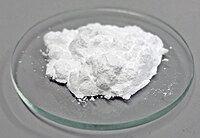
Photo from wikipedia
Abstract Tailoring the surface structure of Earth-abundant perovskite oxides can provide cost-effective, high-efficient, and durable electrocatalysts for oxygen evolution reaction (OER). However, the structural origin leading to high OER performance… Click to show full abstract
Abstract Tailoring the surface structure of Earth-abundant perovskite oxides can provide cost-effective, high-efficient, and durable electrocatalysts for oxygen evolution reaction (OER). However, the structural origin leading to high OER performance of perovskite is not fully understood. Here, we present a strategy of tuning the surface energy density of non-stoichiometric perovskite by creating surface defects in the 3D inverse opal LaCoO3-x (3DIO-LaCoO3-x) through a colloidal template strategy. The defective 3DIO-LaCoO3-x, which has an enhanced surface energy density and a shift in the d-band centre of Co relative to the Fermi level, demonstrates significantly improved intrinsic OER activity, with a TOF (0.21 s−1) ten-folder larger than that of conventional LaCoO3 nanoparticles (0.02 s−1). The defective surfaces of 3DIO-LaCoO3-x are theoretically proven to alter the rate determining step of OER and significantly reduce the adsorption energies of the intermediate species, resulting in dramatically enhanced OER activity. Moreover, rich surface defects with high electrical conductivity can mitigate structural corrosion by fast transfer of charge through defective conductive channels, and thus enables long-term stability for the defective 3DIO-LaCoO3-x. These results provide an effective approach for enhancing the intrinsic activity of perovskite for water oxidation towards understanding the surface structure engineering for perovskite-based materials.
Journal Title: Journal of Power Sources
Year Published: 2020
Link to full text (if available)
Share on Social Media: Sign Up to like & get
recommendations!